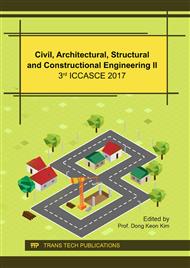[1]
C. J. Kibert, Sustainable construction: green building design and delivery. John Wiley & Sons, (2012).
Google Scholar
[2]
B. G. Hwang, J. S. Tan, Green building project management: obstacles and solutions for sustainable development. Sustain. Dev. 20(5) (2012) 335-349.
DOI: 10.1002/sd.492
Google Scholar
[3]
J. Zuo, Z. Y. Zhao, Green building research–current status and future agenda: A review. Renew. Sustain. Energ. Rev. 30 (2014) 271-281.
Google Scholar
[4]
L. Yang, Green building design: Wind environment of building, Shanghai: Tongji University Press, (2014).
Google Scholar
[5]
J. Colding, Ecological land-use complementation' for building resilience in urban ecosystems. Landscap. Urb. Plan. 81(1) (2007) 46-55.
DOI: 10.1016/j.landurbplan.2006.10.016
Google Scholar
[6]
Ministry of Construction of China. Evaluation standard for green building. GB/T 50378-2014, (2010).
Google Scholar
[7]
L. Yang, B. J. He, M. Ye, Application research of ECOTECT in residential estate planning. Energ. Build. 72 (2014) 195-202.
DOI: 10.1016/j.enbuild.2013.12.040
Google Scholar
[8]
M. Cellura, F. Guarino, S. Longo, M. Mistretta, Energy life-cycle approach in Net zero energy buildings balance: Operation and embodied energy of an Italian case study. Energ. Build. 72 (2014) 371-381.
DOI: 10.1016/j.enbuild.2013.12.046
Google Scholar
[9]
S. V. Russell-Smith, M. D. Lepech, R. Fruchter, Y. B. Meyer, Sustainable target value design: integrating life cycle assessment and target value design to improve building energy and environmental performance. J. Clean. Prod. 88 (2015) 43-51.
DOI: 10.1016/j.jclepro.2014.03.025
Google Scholar
[10]
G. Verbeeck, H. Hens, Energy savings in retrofitted dwellings: economically viable?. Energ. Build. 37(7) (2005) 747-754.
DOI: 10.1016/j.enbuild.2004.10.003
Google Scholar
[11]
K. Parsons, Human thermal environments: the effects of hot, moderate, and cold environments on human health, comfort, and performance. CRC Press, (2014).
DOI: 10.1201/b16750
Google Scholar
[12]
L. Yang, B. J. He, M. Ye, The application of solar technologies in building energy efficiency: BISE design in solar-powered residential buildings. Tech. Soc. 38 (2014) 111-118.
DOI: 10.1016/j.techsoc.2014.03.002
Google Scholar
[13]
C. Scheuer, G. A. Keoleian, P. Reppe, Life cycle energy and environmental performance of a new university building: modeling challenges and design implications. Energ. Build. 35(10) (2003) 1049-1064.
DOI: 10.1016/s0378-7788(03)00066-5
Google Scholar
[14]
F. Qian, Analysis of Energy Saving Design of Solar Building-Take Tongji University solar decathlon works for example, Appl. Mech. Mater. 737 (2015) 139-144.
DOI: 10.4028/www.scientific.net/amm.737.139
Google Scholar
[15]
S. Junnila, A. Horvath, Life-cycle environmental effects of an office building. J. Infrastruct. Syst. 9(4) (2003) 157-166.
DOI: 10.1061/(asce)1076-0342(2003)9:4(157)
Google Scholar
[16]
Y. L. X. Li, Analysis of the Planning of Neighborhood Communication Space in the Livable Community, Appl. Mech. Mater. 174-177(5) (2012) 3018-3022.
DOI: 10.4028/www.scientific.net/amm.174-177.3018
Google Scholar
[17]
U. G. B Council, Leadership in energy and environmental design. Green Building Rating System for Existing Buildings: Upgrades, Operations and Maintenance (LEED-EB), version, 2, (2008).
Google Scholar
[18]
E. Johansson, R. Emmanuel, The influence of urban design on outdoor thermal comfort in the hot, humid city of Colombo, Sri Lanka. Int. J. Biometeorol. 51(2) (2006) 119-133.
DOI: 10.1007/s00484-006-0047-6
Google Scholar
[19]
L. Yang, Green building design: Building energy efficiency, Shanghai: Tongji University Press, (2016).
Google Scholar
[20]
J. Morrissey, T. Moore, R. E. Horne, Affordable passive solar design in a temperate climate: An experiment in residential building orientation. Renew. Energ. 36(2) (2011) 568-577.
DOI: 10.1016/j.renene.2010.08.013
Google Scholar
[21]
T. Fleiter, E. Worrell, W. Eichhammer, Barriers to energy efficiency in industrial bottom-up energy demand models - a review. Renew. Sustain. Energ. Rev. 15(6) (2011) 3099-3111.
DOI: 10.1016/j.rser.2011.03.025
Google Scholar
[22]
J. Yam, Y. Li, Z. Zheng, Nonlinear coupling between thermal mass and natural ventilation in buildings. Int. J. Heat Mass Transf. 46(7) (2003) 1251-1264.
DOI: 10.1016/s0017-9310(02)00379-4
Google Scholar



